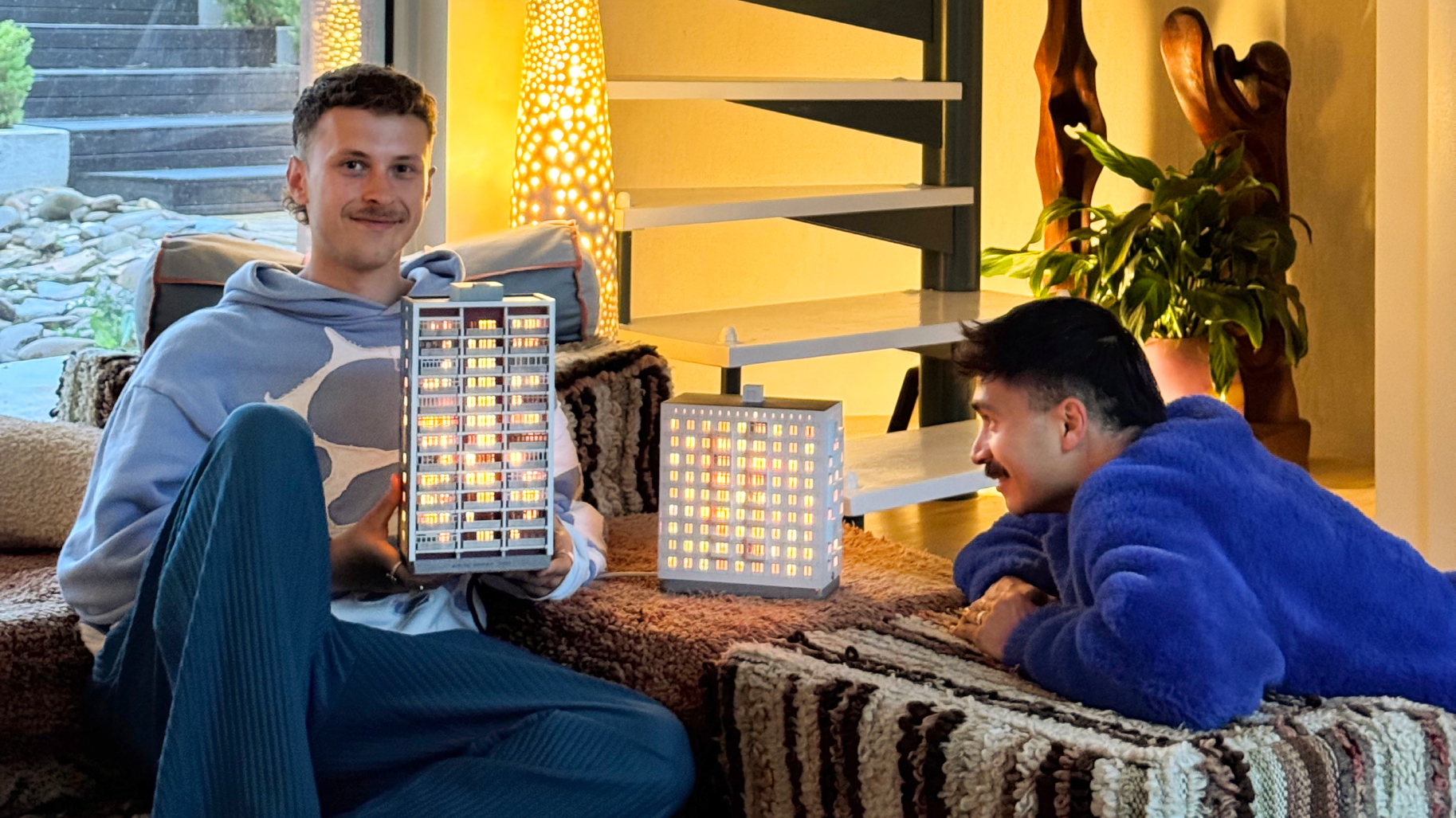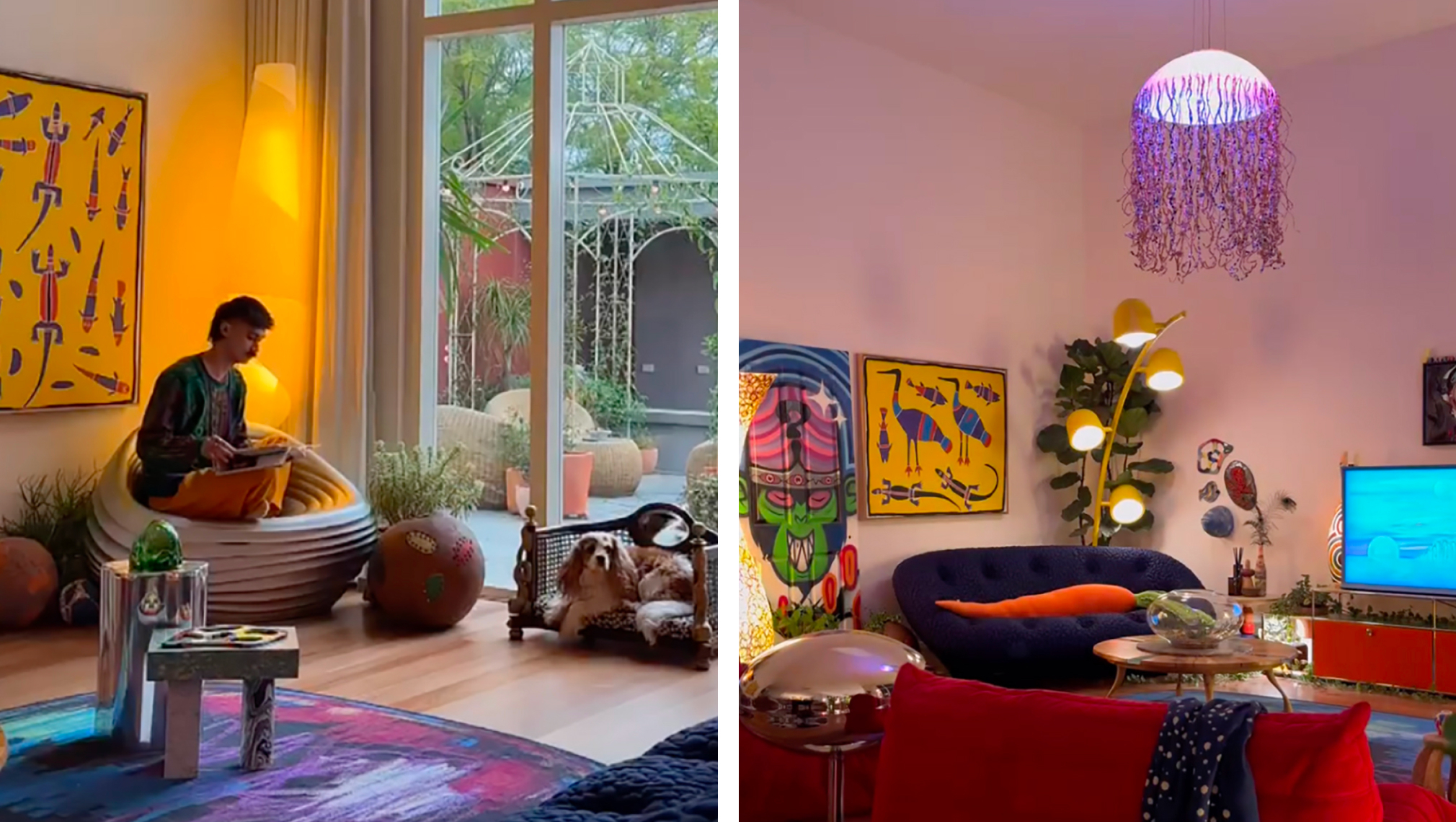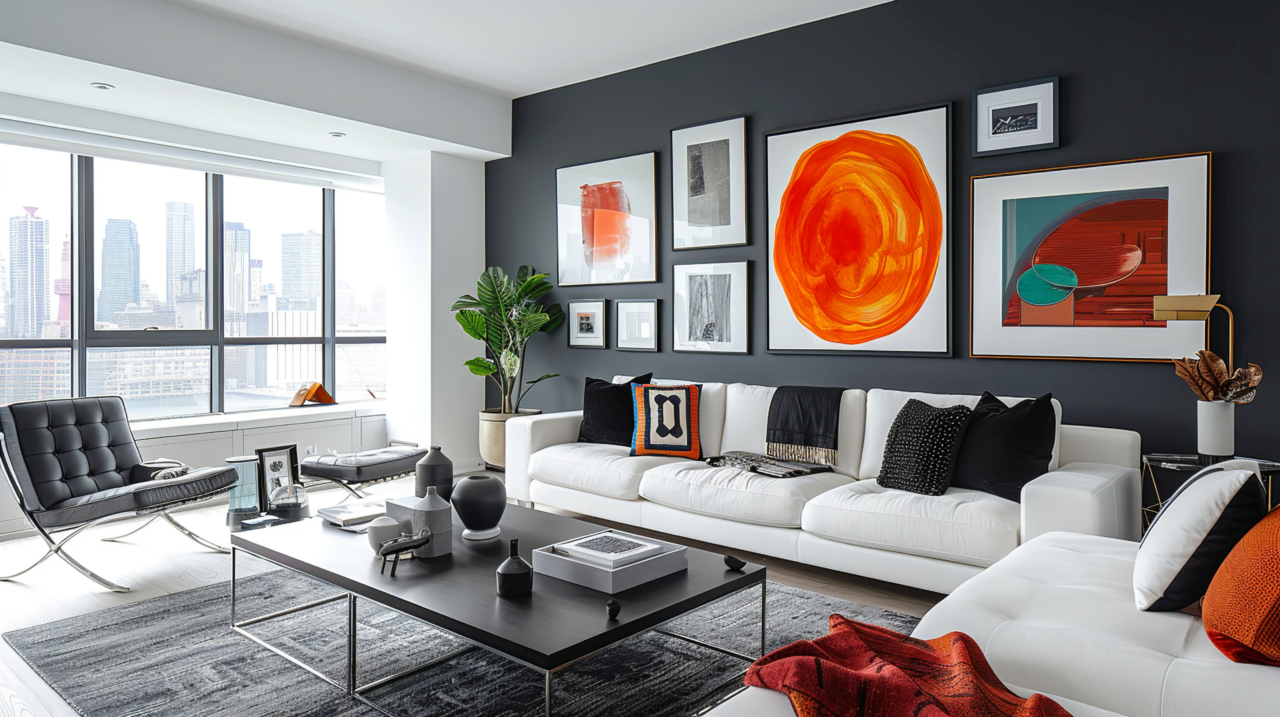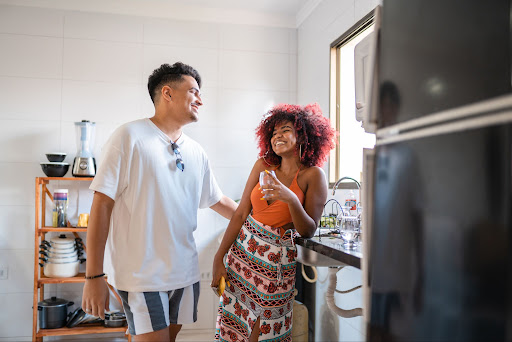An Introduction to the Art of Ambient Lighting
We asked designers Josh and Matt to light the way for beginners.


Written by May Ortega on October 17, 2024
Just because you have ceiling lights to brighten up your new house or rental — maybe you have the notorious “boob lights” — doesn’t mean that’s your only option or that you even need to use them. The right lighting can create that cozy, soothing vibe you can’t wait to come to and many experts agree that those harsh overhead lights don’t exactly cut it.
Enter: ambient lighting, plus Josh and Matt.
Josh Jessup and Matt Moss are artists, interior designers, and content creators near Melbourne, Australia. Ambient lighting is one of their absolute favorite techniques for expressing themselves in their home and creating a comfortable environment at the same time. But what can ambient lighting do for you?
“It turns lighting into art rather than just a function,” Jessup said. “And I think when you go past function and it becomes a part of your personality, that's what makes a house a home.”
Jessup and Moss, who are engaged, have earned millions of followers on their Instagram and TikTok by sharing their creative, maximalist approach to their own home’s design. And ambient lighting is a frequent topic on their social media. So we asked this design duo for their advice on how you can use ambient lighting (and your creativity) to make your space feel like a glowing retreat.
What is ambient lighting?
Ambient lighting is light that illuminates a room in all directions and sets a mood for your space. It can be natural light, artificial light, or a mix of both in various tones, from warm to cool. Jessup and Moss emphasize that becoming versed at ambient lighting is about using light sources intentionally to create a comfortable and inviting atmosphere.
“When you move into a house, it’s got a light in the middle of the room, but it's not really making the most of how you have created your space,” Jessup said. “If you've set up your couch in the corner, you might want a lamp in that corner where you spend the most time.”
The key words associated with ambient lighting are “warm” and “soft” — the goal here is to feel relaxed, but you don’t want things so soft or dim that you’re having trouble seeing. That means you’ll likely also want to integrate task lighting — brighter, focused lights — so that you don’t sacrifice functionality.
What ambient lighting can do for your brain
Several studies have shown that the temperature of the lighting in a room can affect how you feel: warm tones are associated with being more calm, while cool tones support productivity and energy. Jessup has learned how the brightness and even the color of lighting can affect your mood through personal experience.
“I’ve suffered from anxiety my whole life, and the lighting has been something that really helps ground me and just puts me in a relaxed state of mind,” he said.
Avoiding lights that are too bright or too blue (i.e. cool) can make it easier for your brain to shift into rest mode at the end of the day. You don’t want the comfiest parts of your home to feel like an office or a store.
How to craft your own glow
There are lots of ways you can use ambient lighting to make your home feel just right. You can use lamps that come in fun shapes and patterns, or you can find something clean and sleek. What works best for you depends on your individual space and taste.
If you like to decorate in a way that expresses who you are, setting up ambient lighting can be more than just a practical endeavor. It can present your space in a new light (pun intended), and give you the chance to make it even more unique.
Alternatively, if you want to go a more minimalist route, you can still embrace ambient lights. Just use simpler lamps.
Whatever your taste, here are some tips for getting started:
Switch off the overhead lights

Moss and Jessup are not at all fans of what they call “The Big Light.” They’ve compared it to the stark lighting in a hospital. They’ve also made videos showing how it can make people’s faces look unflattering because they’re being lit from above so harshly.
“I look so good under the ambient lighting because it renders your most natural skin tone and it doesn't do those crazy, scary shadows,” Jessup said with a laugh. “I'm looking like a Neanderthal under that overhead lighting.”
Moss said they don’t really use their Big Lights anymore because of the way they’ve arranged their ambient lamps. Even tasks like cooking are done by ambient light or sunlight. If your home has enough natural lighting and artificial lights set up, you may be able to get away with keeping your Big Lights off for days or weeks on end.
“If you don't want to use the big light at all, then you're going to want to have things kind of spread out evenly around the room,” Moss said. “So there are light sources coming from different sites and you just build up your lamp collection over time.”
If you want to work with your existing ceiling lights, install a dimmer switch so that you have more control over the brightness in the space. Or better yet, swap your existing overhead light with a chandelier which can spread soft, refracted light across a whole room. Just check that the chandelier isn’t too big for the room nor that it hangs too low, Jessup said.
Map it out
Before you go out and get a new lamp, audit the functionality of a given area.
“It's kind of just about thinking how you want to use the space and then that will determine what kind of lighting is going to best suit you,” Jessup said.
He suggests reflecting on how you use your house. If there’s a chair you spend a lot of time in, or a corner of a given room that you gravitate towards, think about what kind of lighting could help it feel comfier. For example, come bath time, placing a small lamp on the floor nearby could help you unwind. Then you can get that candle glow without any fuss.
Find a light fixture you love

“Realistically, sometimes you're going to go into a store or a thrift store and you'll find a lamp before you've worked out what you want to do with it,” Jessup said. “And I'd say if it really speaks to your soul, or you feel like it really reflects who you are, just take it and you'll figure it out later.”
Jessup and Moss’s home offers a great example of “going with what feels right.” Their lamps range from a giant nose that hangs on the wall, light emitting from each nostril, to a large arch that’s wrapped in fairy lights, to a set of flowering floor lamps, to a collection of gently lit fish tanks filled with fish and plants.
So, don’t worry too much about the type of lamp you need. Ambient lighting design is fairly flexible, allowing for simple fixtures, or something more complex, like a tasteful chandelier.
Find balance
How much lighting is too much? How many lamps is too many? While there’s no simple answer, Moss suggests aiming for balance.
“That's the main thing, balancing the brightness and the areas of light — because it looks so magical when you have a corner that's just glowing, but then if you just make everything glow, you lose that sort of magic stuff,” he said.
And if you still feel like you need some guidance, Jessup is a fan of the “rule of threes.”
“I just feel like it always works and it's such a safe way to decorate, where you could pair a really tall lamp, and then maybe a shorter table lamp, and then a really small artistic lamp,” he said.
Consider smart bulbs
Jessup and Moss suggest swapping out traditional bulbs with smart lighting, which gives you more control over the color and brightness of your light source.
“It allows that flexibility if you do need task lighting or you need to study … but then that doesn't limit you from having a really nice calming and relaxing environment afterwards,” Jessup said.
Smart bulbs vary in price, the lower end of the range being around $10. Once you’ve got one, just screw it in and download an app. And another fun thing about smart bulbs: you can turn them blue, green, pink, and plenty of other colors for any occasion.
Layer your light
Having a mix of ambient, task and accent lighting in your home helps give it dimension and can help draw the eye to (or away) from anything you want. Accent lighting in particular involves using light to highlight specific things, like a wall sconce pointed up at some framed wall art. Combining these approaches can make for an artistic result that transforms your space without needing to remodel.
“It's about adding another layer to how you furnish your house, being guided by how you live in your house,” Jessup said.
For example, lamps that uplight a room, also called “torchieres”, are useful for creating ambient lighting. The upward light ensures it’s out of your eyes, and spreads across the room more softly than an overhead light does because it's bouncing off the ceiling. Then there are strip lights, thin strips of LEDs that usually have an adhesive backing so you can stick them anywhere you want: along your baseboards or underneath kitchen cabinets, for example. And you can control their brightness and color from your phone.
Once you’ve established your desired glow glow, add a desk lamp that can help you out while you study or read. Lastly, use a small lamp to highlight your book collection or another accent piece (remember Jessup’s rule of threes).
Ambient lighting, in practice
We asked our experts to share their best strategies for using ambient lighting in rooms where you want to feel cozier, such as the living room and the bedroom.
This is a versatile space, where you’re spending time watching TV, catching up with a partner or friends, or maybe even meditating. Because the living room has so many uses, there are many ways to incorporate ambient lighting.
One place to start is with cylindrical floor lamps, which come in different styles and range from three to six feet tall. Look for options with linen shades, or a similar material, and place them in corners of your room — but not completely tucked away — so that they can give off a soft glow in every direction, according to Jessup. Just avoid placing any light source directly across from your TV where you could cause a glare. Instead, put them on either side.
“It's nice to have a little bit of light coming off to just help the TV kind of soften up and not be as bright,” Jessup said.
You’ll also want to test out your lamp placement next to your favorite sitting area.
“You want to make sure there's no light shining directly in your eyes or reflecting off things,” Moss said.
To minimize this, Moss recommends a floor lamp with a flexible neck, so you can bend it in whatever direction you like, or a short lamp that’s below eye level. And whenever possible, avoid lamps that expose bulbs altogether.
“If you have a bulb directly visible and shining into your peripheral, it completely takes away from that relaxed sort of mind,” Jessup said.
The bedroom is a space where you’re winding down, so seek out soft lighting that’s easy to adjust from bed. Whether you opt for table lamps or sconces, make sure you have one on each side of your bed in order to give a uniform brightness to your room.
Again, Moss said it’s especially important to choose lighting where the bulb isn’t at eye level when you’re lying down or sitting up (or directly above your bed), so you can avoid any harsh light in your face in this space of relaxation.
Place a fun floor lamp in a corner next to an accent chair, to serve as a spot where you can put the finishing touches on an outfit when you’re getting ready to go out (and need a little inspiration).
“It is about how you use the space,” Moss said. “If you have a place where you take all your jewelry off and put it on your jewelry stand, then you do want that to be lit up so you're not fumbling around at night.”
We hope these tips help you feel happy in your home, and create a space that brings you calm and creativity.
Tags
Find an apartment you’ll love on Zillow
With Zillions of up-to-date listings and filters for your must-haves, it's easy to find your perfect apartment on Zillow Rentals.
Search rentals
